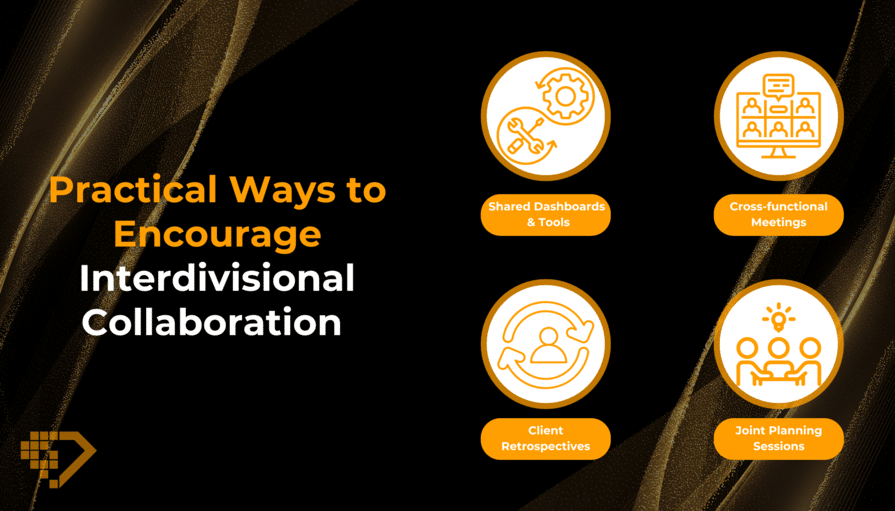In many businesses, internal silos remain one of the biggest barriers to growth. Marketing, sales, product, and operations often work in isolation, leading to inefficiencies, miscommunication, and missed opportunities.
In today’s fast-paced and client-focused environment, collaboration across divisions is no longer optional. It is essential for driving results, fostering innovation, and improving the client experience.
This blog will explore the significant value that cross-team collaboration brings to the table and how it directly contributes to client success and long-term business growth.
The Risk of Operating in Silos
What does “working in silos” mean?
In a business context, “working in silos” happens when divisional teams focus solely on their own objectives without meaningful collaboration with other divisions. While each team might perform well individually, the business as a whole suffers from misalignment.
Consider these examples:
- Marketing develops a campaign, but without input from Sales, the message misses the mark and conversions suffer.
- Product builds new features, but without insights from client-facing teams, those features don’t reflect client needs.
The impact of silos often shows up as:
- Inefficiencies: duplicated tasks, wasted resources, or a lack of clear direction.
- Miscommunication: confusion about goals and expectations.
- Poor client experiences: inconsistent service that undermines trust.
- Over time, working in silos slows response times, reduces innovation, and weakens overall performance.

Why Cross-Functional Teamwork Drives Better Outcomes
When teams collaborate across functions, they work towards a shared goal, rather than focusing solely on individual divisional objectives. This shift in mindset leads to more innovative solutions and better outcomes for clients.
Shared Goals Create Smarter Solutions
When teams unite towards a common goal, the result is typically better problem-solving and more creative solutions. For instance:
- Marketing and sales can align efforts, resulting in campaigns that target the right audience with the right messaging, leading to higher conversion rates.
- Operations and product teams can work together to improve user experience, ensuring features match customer needs and expectations.
Diverse Perspectives Strengthen Strategies
Collaboration encourages a diversity of perspectives that can challenge assumptions and generate more comprehensive strategies. When marketing, sales, and product teams work together, the end result is a more effective, data-driven, and client-centric approach. This focuses on making sure strategies are well-rounded and aligned with client needs, which directly impacts their experience and satisfaction.
Improved Communication = Improved Execution
One of the biggest advantages of cross-team collaboration is strong communication channels. Clear and consistent communication across divisions can drastically improve how quickly and efficiently teams execute their tasks and lead to teamwork success.
- Faster Response Times: When teams communicate effectively, they can quickly react to market changes, customer feedback, or urgent client needs. For example, a marketing team aware of a product update can immediately adjust ad campaigns to reflect new features, preventing wasted ad spend or inaccurate messaging.
- Reduced Duplication of Work: Collaborative workflows help reduce overlapping tasks. By having open communication, teams can ensure that efforts aren’t duplicated, and resources are used efficiently. For example, if a sales team has already addressed a common client query, the client service team can avoid repeating the same answer.
- Smoother Handover Processes: The transition between different stages of client engagement, like strategy to delivery or sales to onboarding, is crucial. If teams communicate well, these handovers are seamless, ensuring that clients receive consistent service. Poor handovers, on the other hand, can lead to delays, confusion, and frustration for clients.
Building a Culture of Collaboration
Collaboration isn’t just about implementing tools – it’s about shaping the right culture within your organisation. Leadership plays a critical role in driving this shift.
- Leadership sets the tone: When leaders prioritise cross-functional teamwork, employees follow suit.
- Aligned KPIs and workflows: Focusing on shared outcomes avoids competition between teams.
- Encouraging informal collaboration: Quick connects, workshops, and casual conversations can be just as impactful as formal meetings. Encouraging these interactions and the importance of teamwork helps break down silos and build stronger relationships across teams.
How Collaboration Impacts Client Success
When the teams behind the scenes are aligned and working together, the benefits extend directly to the client. Collaboration nurtures trust, confidence, and consistency, all of which are essential for long-term client relationships.
- Trust and Confidence: Clients trust businesses that appear unified and consistent. When teams work together seamlessly, clients feel more confident in the service they’re receiving. They know that every touchpoint is well-coordinated.
- Reduced Friction: In a collaborative environment, teams can work through challenges and resolve issues quickly. Whether it’s solving an issue or adjusting an ad campaign, the combined efforts of the team result in quicker resolutions and a smoother client experience.
- Increased Innovation: Collaboration brings together different ideas and skill sets, leading to more innovative solutions. For clients, this means receiving high-quality, creative strategies tailored to their unique needs.

Practical Ways to Encourage Interdivisional Collaboration
To encourage better collaboration, businesses can implement several practical strategies:
- Shared Dashboards and Tools: Tools like Trello, Asana, or Monday.com ensure that everyone has visibility into project timelines, tasks, and progress, promoting transparency.
- Cross-Functional Meetings: Regular cross-functional meetings, such as weekly check-ins or monthly strategy sessions, ensure teams stay aligned on priorities and projects.
- Client Retrospectives: Hold client retrospectives after campaigns or projects to assess performance and discuss improvements. This helps teams learn from each other and refine future strategies.
- Joint Planning Sessions: Encourage teams to work together in planning sessions, where they can contribute their expertise and ideas to form a comprehensive strategy.

How Ruby Digital Encourages Interdivisional Collaboration
At Ruby Digital, we believe in collaboration across all teams to deliver the best results for our clients. We utilise a range of tools and strategies to make sure our teams are aligned, informed, and working together effectively:
- Asana Client Dashboards: We maintain organised, real-time client dashboards on Asana, which provide comprehensive details of each project, including tasks, priorities, deadlines, and key data. This system enables us to monitor client performance, ensuring that every division has a clear understanding of the work in progress and the value being delivered. The visibility helps us keep all teams aligned and ensures nothing falls through the cracks.
- Quarterly Client Success Reviews: Every quarter, teams from various divisions come together for an in-depth review of client progress. These meetings provide an opportunity to discuss challenges, share insights, and identify cross-collaboration opportunities. By evaluating the client’s overall performance and success, we ensure that all teams are aligned on the same objectives and priorities.
- Weekly Group Check-ins: Our weekly group check-ins allow us to assess progress on a shorter time frame. We review key data from the previous week, address any issues related to tracking or alignment with KPIs, and ensure all divisions remain synchronised. This frequent touchpoint helps us stay agile and responsive to the needs of our clients.
- Weekly Individual Check-ins: These one-on-one meetings give team members a chance to discuss the specific services they are managing. This ensures that each department has a clear understanding of its contribution to the client’s overall strategy and allows for immediate adjustments if needed.
- Microsoft Teams for Quick Collaboration: To streamline communication, we use Microsoft Teams groups for efficient and quick exchanges of information. This platform enables teams to ask questions, share updates, and track deadlines in real-time, ensuring that everyone has access to the latest information and is always on the same page.
By employing these tools and methods, we create a collaborative environment that allows us to drive success for our clients and ensure a high level of communication across all divisions.
Cross-team collaboration isn’t just a nice-to-have – it’s a fundamental component of sustained success. Organisations that prioritise internal alignment deliver greater value externally by providing more innovative solutions, faster response times, and improved client experiences.
By fostering a culture of collaboration, companies can achieve more consistent results, stronger client relationships, and long-term business growth.



